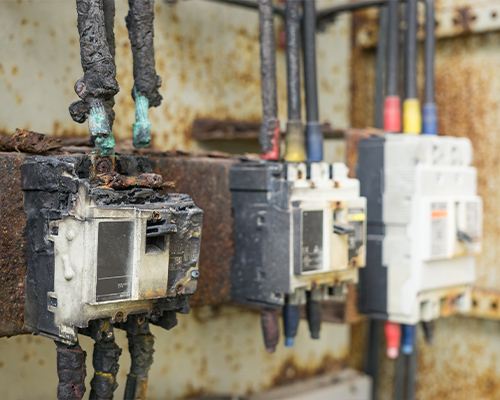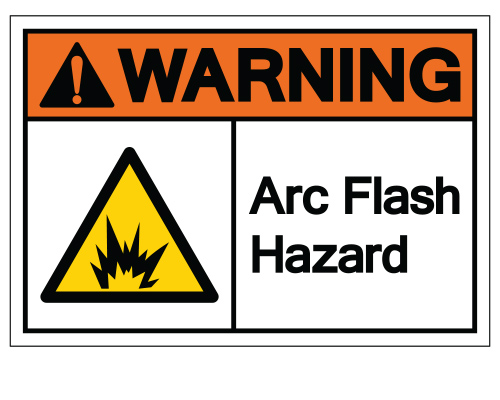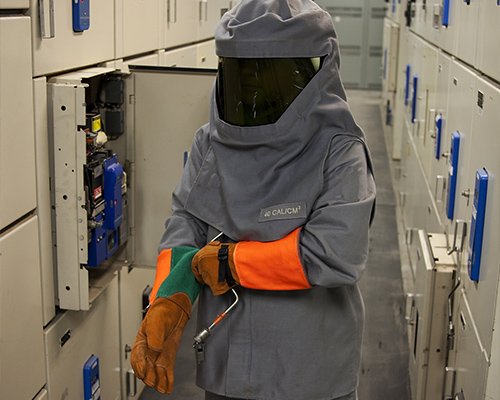ARC FLASH SAFETY MANAGEMENT
ARC FLASH SAFETY MANAGEMENT
Arc Flash Safety management
Exeltech Ltd has a wealth of experience in the management and risk assessment of Arc Flash throughout the world.
What is an electric arc flash?
An arc flash is usually caused by inadvertent contact between an energised conductor such as a bus bar or wire with another conductor, or an earthed surface. When this occurs, the resulting short circuit current melt the conductors, ionise the air and create a conducting plasma fireball with temperatures in the core of the arc that can reach upwards of 20,000 degrees centigrade or several times the temperature of the sun. Severe injury and even death can not only occur to persons working on the electrical equipment, but also to people located nearby.


Arc flash injury can include external burns to the skin, internal burns from inhaling hot gases and vaporised metal, hearing damage, eye damage such as blindness from the ultraviolet light of the flash, as well as many other devastating injuries.
Depending on the severity of the arc flash, an explosive force known as an arc blast may also occur, which can result in pressures of more than 100 kiloPascal (kPa), launching debris such as shrapnel at speeds of up to 300 metres per second (m/s).
Survivors of such injuries may require extensive treatment and rehabilitation and the cost of these injuries can be extreme – physically, emotionally and financially. While legislation requires businesses to perform risk assessments for all work activities, electric arc risk is often overlooked because most people are unsure how to assess and manage this hazard effectively.
Arc flash injury can include external burns to the skin, internal burns from inhaling hot gases and vaporised metal, hearing damage, eye damage such as blindness from the ultraviolet light of the flash, as well as many other devastating injuries.
Depending on the severity of the arc flash, an explosive force known as an arc blast may also occur, which can result in pressures of more than 100 kiloPascal (kPa), launching debris such as shrapnel at speeds of up to 300 metres per second (m/s).
Survivors of such injuries may require extensive treatment and rehabilitation and the cost of these injuries can be extreme – physically, emotionally and financially. While legislation requires businesses to perform risk assessments for all work activities, electric arc risk is often overlooked because most people are unsure how to assess and manage this hazard effectively.

How likely is an arc flash?
Within the subject of electrical injury in the workplace, the likelihood of arc flash is minimal and is generally accepted.
However, damage to property and personnel, should arc flash occur tends to be far higher than with other electrical injuries in the workplace. There are a host of factors from the surrounding environment to equipment suitability and age that play a part in the likelihood of an arc flash event.
In many cases, clients often believe their arc flash risk is more significant at high voltage HV (above 1000Vac). However, we’ve found, in our experience of carrying out arc flash studies, the risk is far more significant at low voltage due to longer tripping times.


Training Staff In Prevention & Management?
Training Staff In Prevention & Management?

What Does the Law Say About Safety
and the Management of Arc Flash?
The Electricity at Work Regulations 1989 provide legislative guidance to employers and places a legal obligation on them to ensure the safety of electrical devices in their workplace. Regulatory statements found within this legislation, and other related regulations, and their direct relation to the hazard of an arc flash can be found below:
Regulation 2 – Interpretation:
“injury” death or personal injury from electric shock, electric burn, electrical explosion or arcing, or from fire or explosion initiated by electrical energy,….”
Regulation 4 – Systems, work activities, and protective equipment:
“Every work activity, including operation, use and maintenance of a system and work near a system, shall be carried out in such a manner as not to give rise, so far as is reasonably practicable, to danger.”
Regulation 16 – Persons to be competent to prevent danger and injury:
“No person shall be engaged in any work activity. Where technical knowledge or experience is necessary to prevent danger or,
Where appropriate, injury, unless he possesses such knowledge or experience, or, Is under such degree of supervision as may be appropriate having regard to the nature of the work.”
Regulation 3 of the Management of Health and Safety at Work Regulations
“…requires a suitable and sufficient assessment of risk to be undertaken and the regulations then go on to establish a hierarchy of control through Schedule 1.”
Personal Protective Equipment Regulations 1992 – Regulation 6 Assessment of personal protective equipment:
“Before choosing any personal protective equipment which under regulation 4 he is required to ensure is provided, an employer or relevant self-employed person shall ensure that an assessment is made to determine whether the personal protective equipment he intends to provide is suitable.”
What Does the Law Say About Safety
and the Management of Arc Flash?
The Electricity at Work Regulations 1989 provide legislative guidance to employers and places a legal obligation on them to ensure the safety of electrical devices in their workplace. Regulatory statements found within this legislation, and other related regulations, and their direct relation to the hazard of an arc flash can be found below:
Regulation 2 – Interpretation:
“injury” death or personal injury from electric shock, electric burn, electrical explosion or arcing, or from fire or explosion initiated by electrical energy,….”
Regulation 4 – Systems, work activities, and protective equipment:
“Every work activity, including operation, use and maintenance of a system and work near a system, shall be carried out in such a manner as not to give rise, so far as is reasonably practicable, to danger.”
Regulation 16 – Persons to be competent to prevent danger and injury:
“No person shall be engaged in any work activity. Where technical knowledge or experience is necessary to prevent danger or,
Where appropriate, injury, unless he possesses such knowledge or experience, or, Is under such degree of supervision as may be appropriate having regard to the nature of the work.”
Regulation 3 of the Management of Health and Safety at Work Regulations
“…requires a suitable and sufficient assessment of risk to be undertaken and the regulations then go on to establish a hierarchy of control through Schedule 1.”
Personal Protective Equipment Regulations 1992 – Regulation 6 Assessment of personal protective equipment:
“Before choosing any personal protective equipment which under regulation 4 he is required to ensure is provided, an employer or relevant self-employed person shall ensure that an assessment is made to determine whether the personal protective equipment he intends to provide is suitable.”
How can Exeltech Ltd Help?
EXELTECH LTD provides a unique approach for the management of the arc flash hazard and risk reduction activities.
- Arc flash, risk assessments Studies and subsequent Electrical System Studies including Protection Coordination and Fault Level Analysis
- Recommendations for Risk Reduction and hazard mitigation activities including engineering and Personal Protective Equipment Recommendations
- Bespoke onsite Awareness and Practical Risk Assessment training
- Arc flash guidance, policies & written statements in line with global standards
- Incident investigations & analysis
How can Exeltech Ltd Help?
EXELTECH LTD provides a unique approach for the management of the arc flash hazard and risk reduction activities.
- Arc flash, risk assessments Studies and subsequent Electrical System Studies including Protection Coordination and Fault Level Analysis
- Recommendations for Risk Reduction and hazard mitigation activities including engineering and Personal Protective Equipment Recommendations
- Bespoke onsite Awareness and Practical Risk Assessment training
- Arc flash guidance, policies & written statements in line with global standards
- Incident investigations & analysis
